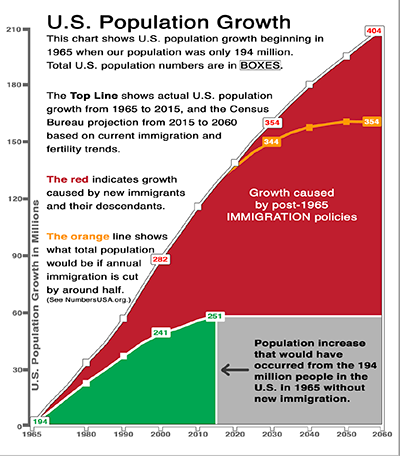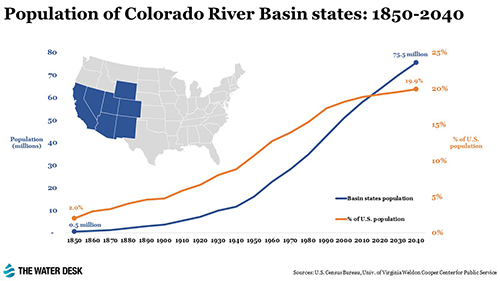Agriculture, development, and population growth
The article Agriculture, development, and population growth was published by Amy Boylan on NumbersUSA, June 12, 2020.
The demand for land and water have increased along with our population. Our current growth trajectory predicts our population will reach 440 million by 2065. This has created a need for additional land to be used for both development and agriculture - both of which then compete for the same water supply.
Areas in the Southwest and West are seeing increases in population and experiencing the environmental impacts of this growth. Journalist Alexandra Tempus, writes, “This region is also experiencing explosive population growth—with Idaho, Nevada, Arizona and Utah topping the list of states with the highest percentage increase in residents from 2018 to 2019, according to the U.S. Census Bureau.” Development has subsequently occurred in order to accommodate the needs of new residents, which further perpetuates urban sprawl that comes with a myriad of its own issues, one of which is an increased demand for water. This is especially problematic as eleven western states are in the midst of a drought - including Arizona, Utah, and Nevada that, as previously noted, are also seeing explosive growth. As a result, there is a need to address water-supply issues during a time that has been the driest since the 1500s.
The three aforementioned states along with California, New Mexico, Colorado, and Wyoming each rely on the Colorado River for their water supply, which is used to provide water for around 40 million people. However, its flow has been decreasing and is expected to continue to do so. Patricia Mulroy, a board member of the Water Research Foundation and general manager of the Southern Nevada Water Authority, said “...when officials allocated the Colorado’s water to different states in 1922, no one expected so many people to be living in the Nevada Desert…” And these numbers are rising. For example, Buckeye, a suburb of Phoenix, currently uses 11,800 acre-feet of water per year, said Ron Whitler, the city’s hydrologist. However, the city council is projecting that based on population growth projections, 200,000 acre-feet will be needed annually within 20 years. As a result, the number of people relying on the Colorado River continues to rise, even as the water flows and reservoir levels fall. And this isn’t unique, as the Rio Grande is experiencing similar declines while also serving a growing population.
The agricultural industry is also tasked with providing for more due to the increasing population --needing more land and more water while working with less of both natural resources. The Head of Sustainability with Syngenta, Jennifer Shaw, Ph.D., explains, “Meeting the demands of a growing population is nothing new to agriculture. Today the American farmer feeds an average of 144 people, almost an eight-fold increase from 1940. Most of the increase has come from higher yields. Per-acre production of corn, for example, has doubled since 1970.” While these increases occur from biotechnology and the more efficient, effective use of water, they can only do so much as demand continues to increase with no end in sight.
While agricultural technology continues to improve yields per acre, the needs of a growing population will require additional land and water for production. A new study is showing that there has been an underestimation for how much land and irrigation is actually needed for agriculture to support the growing population. Completed in part by the Princeton Environmental Institute, the new data shows the acreage needed for irrigation over the next 30 years will be greater than previously thought, as earlier models indicated that globally 590 million to 1.1 billion acres would need to be irrigated; however, this new research shows that irrigated acreage required could reach upwards of 4.4 billion acres.
Further complicating matters is that agriculture and development tend to compete for the same lands with little or no slopes and the best soils, and on a daily basis, both rural and urban farmland is lost to commercial development. In fact, nationwide, about 175 acres per hour of agricultural land is lost to development, which is the equivalent of 3 acres per minute. Dan Nosowitz reports that it is the best and more fertile land that is falling to growth:
Farmland with a high rating is being lost disproportionately quickly, which means suboptimal farmland will have to be used. And suboptimal farmland requires more water, more transportation, more energy, more fertilizers, and more pesticides to be productive, all of which are bad for the environment.
The path we are on is unsustainable and our expectations of what our land and water supply can provide as our population continues to increase are inflated and unrealistic. While technological advances may buy some time, the reality is that our current population growth will only continue to create the need for additional development and increase demand for food production, both of which have environmental implications.
We know that our population growth is being decided primarily due to Congress’s immigration policies that drive 88% of our growth. If we were able to reduce this number, the need for quick-fixes and pressures for technological advances to protect our land and water resources would not be so urgent or dire. It is well within the ability of our country’s leaders to reduce our growth through meaningful legislation that will lower our rates of immigration. Without reducing our population growth, there will soon come a time when we have reached the limits to what our land and water supply can provide
Amy Boylan is Content Writer for NumbersUSA's Sustainability Initiative
Updated: Fri, Jun 12th 2020 @ 1:50pm EDT
NumbersUSA's blogs are copyrighted and may be republished or reposted only if they are copied in their entirety, including this paragraph, and provide proper credit to NumbersUSA. NumbersUSA bears no responsibility for where our blogs may be republished or reposted. The views expressed in blogs do not necessarily reflect the official position of NumbersUSA.


